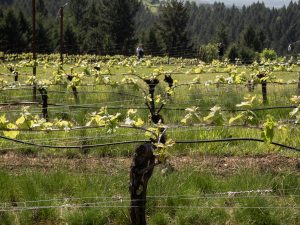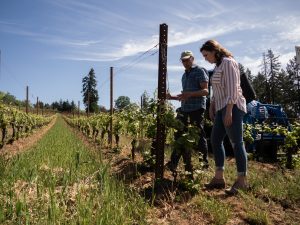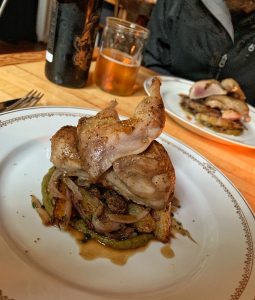If Oregon wine country is not already on your map, it should be.
I just returned from my first trip to Willamette Valley, Oregon, where I spent my days sipping Pinot Noir and spent my evenings drinking more Pinot Noir with awesome food. Safe to say reality has been a hard hit after my dreamy vineyard escape.

Known for cool climate Pinot Noir, Willamette Valley boasts hundreds (maybe even thousands) of Pinot Noir labels.
All Willamette Valley Pinot Noirs are crafted from grapes in this one region that stretches from Eugene to Portland. Each bottle labeled as a Pinot Noir is required to contain at least 95% Pinot Noir grapes. This means you are truly tasting differences in the vineyard terroir when you try different bottles of Pinot side-by-side.

Don’t know what “terroir” is?
It’s basically a fancy word that describes the environment where a wine is produced. It refers to climate, soil type, topography, and sometimes even specific wine-growing techniques. All of these factors influence the quality of the grape produced in the wine. In tandem, terroir impacts the flavor of the bottled wine, too.
Cool climate wine regions refer to places, such as the Willamette Valley, that maintain relatively cool and consistent climates during the grape-growing season.
This season generally lasts from April through October, or whenever the grapes are fully ripened and ready to be harvested. Cool climate means no super-hot days and no extra cold nights. Vines are typically trained to grow high on a trellis to encourage grape ripening in the warm, but not too hot, sunshine. This differs from warmer climates, where vines are trained to form a canopy over the fruit to protect it from sunburn or over-ripening. Yes, grapes get sunburnt.

The Pinot Noir grape happens to grow incredibly well in cool climates.
This is largely due Pinot’s thin skin and susceptibility to damage with large fluctuations in temperature. Willamette Valley boasts Pinot Noirs that are typically light-bodied, tart, fruit-forward, and showcase subtle complexity of flavor. This isn’t your typical ‘pack a punch’ full-bodied red wine. This wine makes you stop, consider the balance of flavors in the wine, and savor every sip,

When touring the Willamette Valley, you will often hear it compared to France’s Burgundy wine region.
Both wine-growing regions benefit from similar climates and latitudes, which cater to the needs of the Pinot Noir and Chardonnay grapes. In fact, as Willamette Valley was established as a wine-growing region, clones of plants were imported from Burgundy to form various vineyard plots in northern Oregon. That means the same exact plant grown in opposite sides of the world has the ability to present two completely different wines. Don’t believe me? Take a look at this deductive Old World (France) vs. New World (Oregon) Pinot Noir tasting by Madeline Puckette to see how different these two wine-growing regions can be!

So, how should you know if a cool climate Willamette Valley Pinot Noir is for you?
If you prefer your wines with a lighter body, or enjoy pairing wines with milder foods (such as fish, duck, or mushrooms), an Oregon Pinot Noir should be on your short list.

There’s an incredible amount of competition for shelf space, notoriety, and label recognition in the wine industry.
It’s no different in the Willamette Valley. Know that your grocery store selection of Oregon Pinots, especially if you’re outside of the Willamette Valley, will be limited. However, there’s hope! Most winemakers in the Willamette Valley prefer to conduct their business direct-to-consumer instead. Consider visiting the region for tastings in order to select your favorite wineries, or read into tasting notes to select bottles that you think you will like. You can also visit local wine shops that may have relationships with some Willamette Valley wineries and ask for advice (or tastings) on the wine.
Here were some of my favorite Pinot Noirs that I tasted when I visited:
2016 Riservata Pinot Noir
Smooth like velvet with rich, oaky flavors from aging in new oak barrels.
2016 Cuvee Pinot Noir
A “quaffing wine” (as described by the winemaker, Wayne Bailey), perfect for drinking alone or pairing with food.
2015 Natasha Pinot Noir
Full-bodied, big tannins, and bold enough to hold up to a steak! (Unusual for a Pinot!)
2015 Karen’s Pommard Pinot Noir
Smells like chocolate and showcases depth of flavor with each sip, becoming more interesting as you enjoy!
2016 Titan Pinot Noir
Balanced with both spice and berry flavors, this wine showcases what some perfect Oregon weather can do for the vines.
2015 Merci Reserve Pinot Noir
Very aromatic, dark in color, smooth, with notes of cherry pie and baking spice.
Any label from these vineyards is a safe bet for your next wine purchase. Each winery listed here sells direct to consumer, too. Check out their websites (linked above) for more information on their wines and shipping to your location.
What are your thoughts on cool climate Pinot Noirs? Do you love their subtle, light-bodied, and sometimes tannic flavor profiles? Do you prefer bolder reds instead? Let me know in the comments below!
Like what you see? Follow along on social media!
